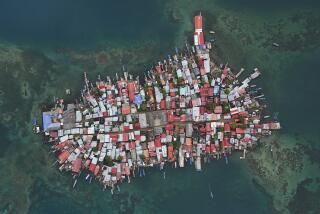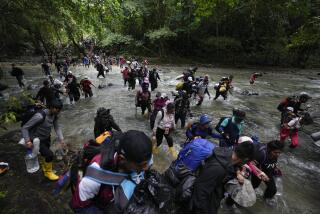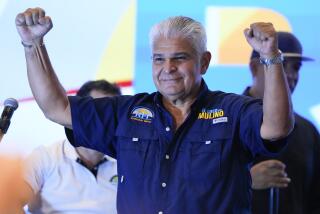After Noriega, Financial Ruin, Panama Is Back
PANAMA CITY — Six years ago this month, Manuel A. Noriega was identified by major U.S. newspapers as a top drug figure, and the country he ran began an economic and political decline that ended in financial disaster and military ruin. Today, at least economically, Panama is back.
By the time American troops invaded in December, 1989, overthrowing Noriega’s government and putting him in prison, Panama’s economy basically had ceased to exist as a result of a U.S. embargo.
The economy was shrinking with negative growth, nearly half the country was unemployed and many of those working were employed in bogus government positions. The international banks were reduced to inactivity, with their deposits dropping from $38 billion in 1986 to no more than $4 billion.
Even the narcotics trade, which led to the sanctions, was cut back because of increased U.S. interdiction and the isolation of the banks.
That was then. Now, the nation’s annual economic growth rate is the highest in Central America. At 9.3% in 1991, it was among the strongest in the world. Per capita income is the highest in the region, and inflation has fallen to less than 15% and is expected to continue dropping.
Stores are full of goods, and the streets are full of cars; housing construction is at record levels; the Panama Canal is running at capacity, and international financial institutions are eager to lend the government hundreds of millions of dollars.
According to many private economists, “the amazing factor about this near-miracle,” as one of them put it, is that the recovery is nearly all the result of private enterprise and happened almost in spite of the actions of the Panamanian and American governments.
“The figures from Washington and the (U.S.) Embassy sound good, and (President Guillermo) Endara and his Cabinet want to take credit,” a European diplomatic economist said. “But the fact is that it has been the store owners and the manufacturers and the bankers that have brought Panama back.”
Initial findings by investigators from the American Congress’ General Accounting Office support that assessment.
According to an edited version of a draft GAO report obtained privately here, not even half of the $1-billion aid program promised by President Bush has been distributed, and much of what has been allocated has had “no significant impact on the economy.”
The report, which is not a final GAO assessment, said that bureaucratic and political considerations by both Washington and Endara’s new government were major causes for the ineffective aid program and that there were serious miscalculations of what was really needed for recovery.
This was particularly true in the banking sector, the report found, because American and Panamanian experts alike recommended unnecessary funding for banks here to head off a feared run on deposits.
“That was understandable,” a prominent Panamanian banker said about the report. “We were afraid our banks would go under. As it turns out, we needed far less.”
As it turned out, deposits rose quickly and dramatically, climbing to $11.4 billion in December, 1990, and $17.1 billion at the beginning of this year. “With the inaction of the government and the slow pace of American aid, we had to provide the credit if there was to be a recovery,” the banker said.
Even taking into account mistakes, mismanagement and even political rivalry, Panama’s private economic performance is impressive. That is evident all over Panama City, where well over half of the country’s 2.4 million people live. A glance in almost any direction shows a skyline featuring newly constructed high-rises, partially completed structures or the cranes that indicate a new building is about to go up.
“Housing permits during 1991 increased by 148% from 1990 levels,” according to a report issued by the Panama Canal Commission. “That pace is continuing this year,” an American economist said. There was a huge, pent-up demand from the last of the Noriega years when nothing was being built.
“Besides,” he added, “the destruction of December, 1989, (when U.S. forces invaded and overthrew Noriega) reduced what was already a short supply of adequate housing.”
The resulting housing shortage has driven up prices to the point where small, two-bedroom apartments in middle-class areas of the city rent for $1,500 dollars a month, plus perhaps $300 monthly in utility costs.
“At those prices, builders are rushing to get into the market,” said the president of one of Panama’s most important banks.
The housing boom has stimulated major growth in related industries, particularly those making construction goods. This has led to manufacturing and sales figures equal to or even higher than the pre-crisis figures of 1986.
“We don’t think the boom will keep expanding,” said a diplomat, citing a projected 7% growth rate for 1992, “but even at that leveled-off status, Panama will remain the healthiest economy in the region.”
Some government economists say growth could still increase. Vice President Guillermo (Billy) Ford, who also is the government’s economic planning minister, pointed to a breakthrough in a dispute over Panama’s public debt.
After failing to reach an agreement on nearly $700 million in interest on loans acquired by past governments, Endara and Ford negotiated a settlement last January with international lending agencies.
That led to an immediate $120-million loan from the World Bank, the first such loan to Panama in more than five years.
“This means that along with the benefit of other international loans, the government will be able to take up the slack left by the leveling off of the private sector,” Ford said.
The Canal Commission report agreed, saying that “barring unforeseen developments, economic expansion in 1992 should be at a rate similar to that of 1991.”
Problems remain, and some may take years to solve. Unemployment is high and is centered in areas that many economists estimate may be beyond help.
Furthermore, the unemployed are considered to have too little education and training to compete in a restricted job market.
“That can be fixed,” said businessman Aurelio Barria, who also heads the Emergency Social Fund, which administers a $31-million program to create better economic conditions in the countryside.
More to Read
Sign up for Essential California
The most important California stories and recommendations in your inbox every morning.
You may occasionally receive promotional content from the Los Angeles Times.










